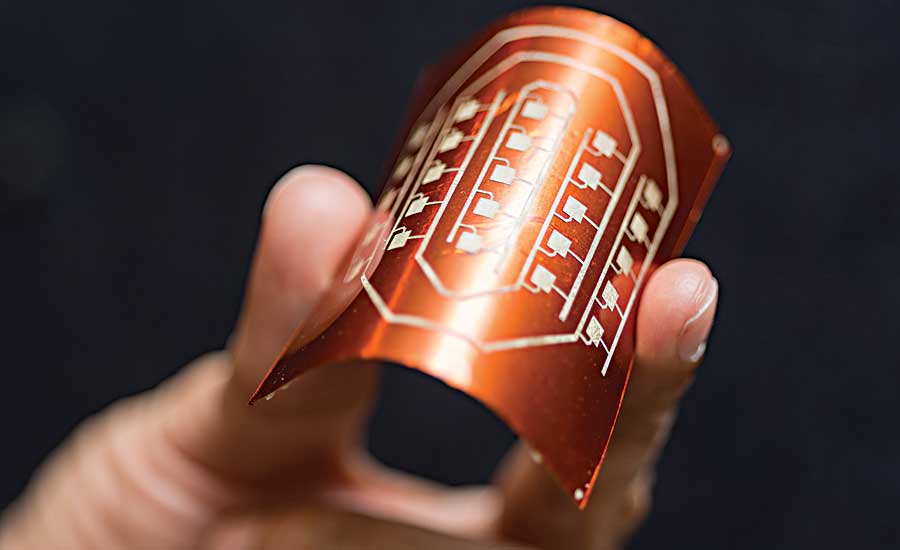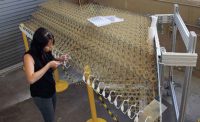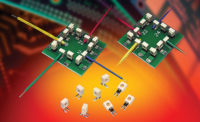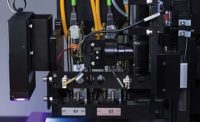By 2030, electronics content will account for 50 percent of an automobile’s total production cost. Earlier this decade, it was only 30 percent.
As the amount of onboard electronic components increases, packaging and weight become critical issues facing automotive engineers.
The solution may be a new breed of flexible electronics. They feature circuits and systems that can be bent, folded, stretched or conformed without losing their functionality. The systems are created using machines that can print components using conductive ink on flexible surfaces.
“Hybrid electronics involve a mix of elements such as logic, memory, sensors, batteries, antennas and various passives which may be printed or assembled on flexible substrates,” says Manos Tentzeris, an electrical engineering professor at the Georgia Institute of Technology who specializes in flexible electronics.
“Combined with low-cost manufacturing processes, flexible hybrid electronics will present an entirely new paradigm for a wide range of automotive applications,” adds Tentzeris.
Potential applications include antennas, body parts, cockpits, loudspeakers, mounted structures and sensors. Flexible electronics can be incorporated into bumpers, head-up displays, instrument panels, seats, tires, windows and many other auto parts.
According to Tentzeris, flexible electronics can be directly printed onto a wide variety of materials or surfaces, including fabric, glass, plastic and wood. They can also withstand high temperatures above 250 C.
The technology appeals to automotive engineers because of its weight-saving potential. “Flexible electronics are 60 percent to 80 percent lighter than traditional chip-based devices,” claims Tentzeris.
Other attributes include the inexpensive nature of printed electronics and the availability of a wide range of substrate materials in large panel forms.
Tentzeris and his colleagues have been developing flexible electronics for more than 12 years. They’ve already performed numerous tests to gauge how mechanical and electrical characteristics change under repeated bending, stretching and twisting over a wide range of temperatures.
They’re currently working on an R&D project with Boeing to create a flexible array antenna that could be incorporated into a plane fuselage or a car body.
“By fabricating large, broadband antenna arrays using a combination of additively manufactured silver, carbon nanostructures, such as graphene and nanotubes, and magnetic materials on several layers on flexible substrates, we will fundamentally stretch the flexible antenna technologies to frequencies better by one to two orders of magnitude compared to the current state of the art,” says Tentzeris. “This will enable the first millimeter-wave flexible broadband wireless module applications, such as smart skins.”
Georgia Tech recently joined a consortium of other organizations, including the U.S. Department of Defense, called the Flexible Hybrid Electronics Manufacturing Innovation Institute (NextFlex). The goal of the group is to “usher in an era of electronics on everything.”
They envision a wide variety of new automotive applications, such as injection-molded structural electronics and organic light-emitting diode (OLED) displays. Companies already commercializing the technology include GSI Technologies LLC and TactoTek Inc.
Faurecia, a leading Tier 1 supplier of interior components, recently invested in TactoTek, which is a startup based in Finland. It’s working to integrate printed circuits and electronic components into injection-molded plastics to create “intelligent surfaces.”
Another major auto parts supplier, Visteon, is also exploring ways to incorporate flexible electronics into its products. Earlier this year, it unveiled an all-digital instrument cluster that features curved displays and flexible OLED technology.
Compared to traditional LCDs used for dashboard displays, OLEDs are thinner, more flexible and can operate without a back light.




